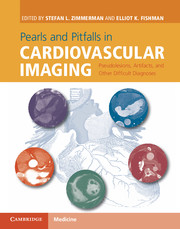 Pearls and Pitfalls in Cardiovascular Imaging
Pearls and Pitfalls in Cardiovascular Imaging from Section 8 - Post-operative aorta
Published online by Cambridge University Press: 05 June 2015
Imaging description
In patients with prior cardiothoracic surgery requiring cardiopulmonary bypass, felt pledgets are used to ensure hemostasis during closure of cannula sites in the ascending aorta. On imaging, these pledgets are high attenuation and are located immediately adjacent to the aortic wall in the high ascending aorta (Figure 66.1). Sometimes on axial source images these high-attenuation foci can mimic small pseudoaneurysms. Correct diagnosis of surgical material can be made by inspection of volume-rendered images, which will often show a rectangular shape (Figures 66.1 and 66.2). Non-contrast images, if available, will also be helpful for showing pledgets as highattenuation precontrast (Figure 66.1).
Importance
Misdiagnosis of pseudoaneurysm of the ascending aorta can lead to inappropriate additional follow-up scans or, in the worst case scenario, repeat surgery.
Typical clinical scenario
Felt pledgets are used for suturing of cannula sites when cardiopulmonary bypass is used, such as for cardiac surgery or thoracic aortic repair.
Differential diagnosis
Surgical material should be distinguished from true aortic pseudoaneurysms, which can occur at cannula sites or anastomoses due to suture break down after thoracic surgery. These will be recognized by a narrow-necked connection to the aortic lumen and attenuation that is similar to blood pool on both pre- and post-contrast imaging.
Teaching point
Felt pledgets adjacent to the ascending aorta in patients with prior cardiothoracic surgery should not be mistaken for pseudoaneurysms. High attenuation on precontrast scans and characteristic shape on volume-rendered reconstructions will allow definitive diagnosis.
To save this book to your Kindle, first ensure no-reply@cambridge.org is added to your Approved Personal Document E-mail List under your Personal Document Settings on the Manage Your Content and Devices page of your Amazon account. Then enter the ‘name’ part of your Kindle email address below. Find out more about saving to your Kindle.
Note you can select to save to either the @free.kindle.com or @kindle.com variations. ‘@free.kindle.com’ emails are free but can only be saved to your device when it is connected to wi-fi. ‘@kindle.com’ emails can be delivered even when you are not connected to wi-fi, but note that service fees apply.
Find out more about the Kindle Personal Document Service.
To save content items to your account, please confirm that you agree to abide by our usage policies. If this is the first time you use this feature, you will be asked to authorise Cambridge Core to connect with your account. Find out more about saving content to Dropbox.
To save content items to your account, please confirm that you agree to abide by our usage policies. If this is the first time you use this feature, you will be asked to authorise Cambridge Core to connect with your account. Find out more about saving content to Google Drive.